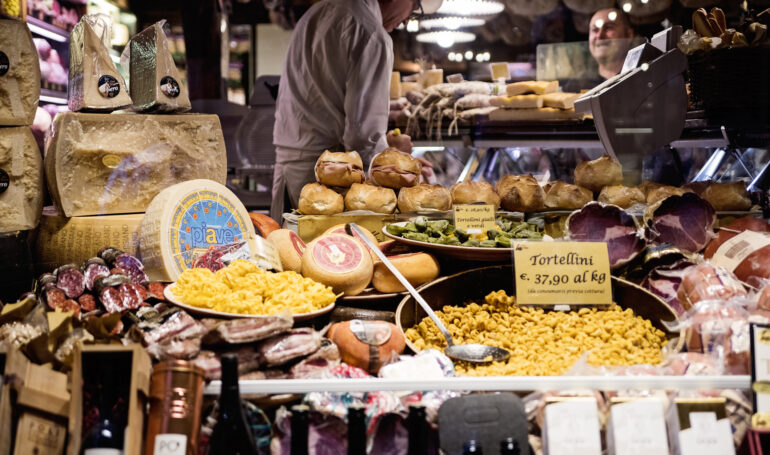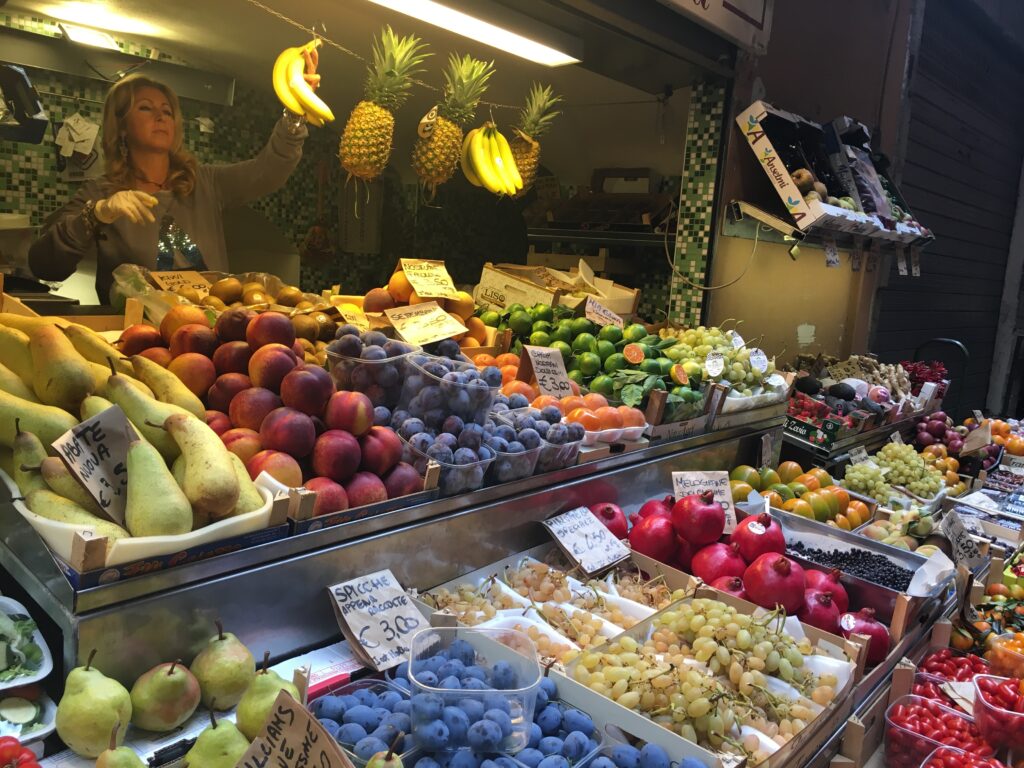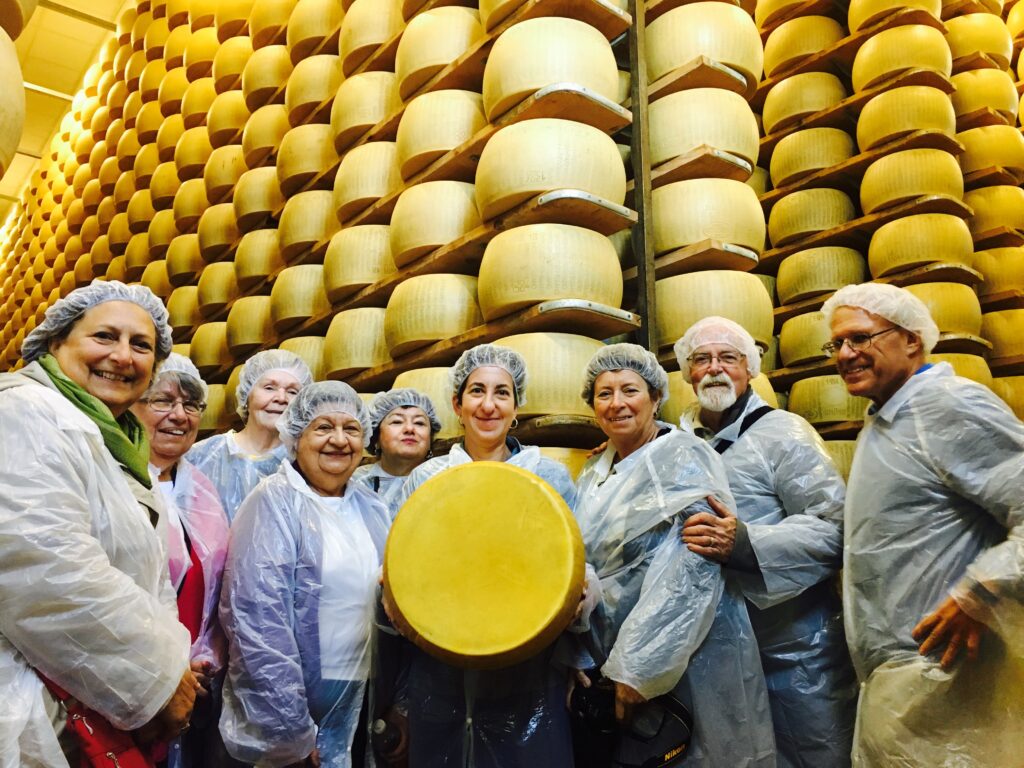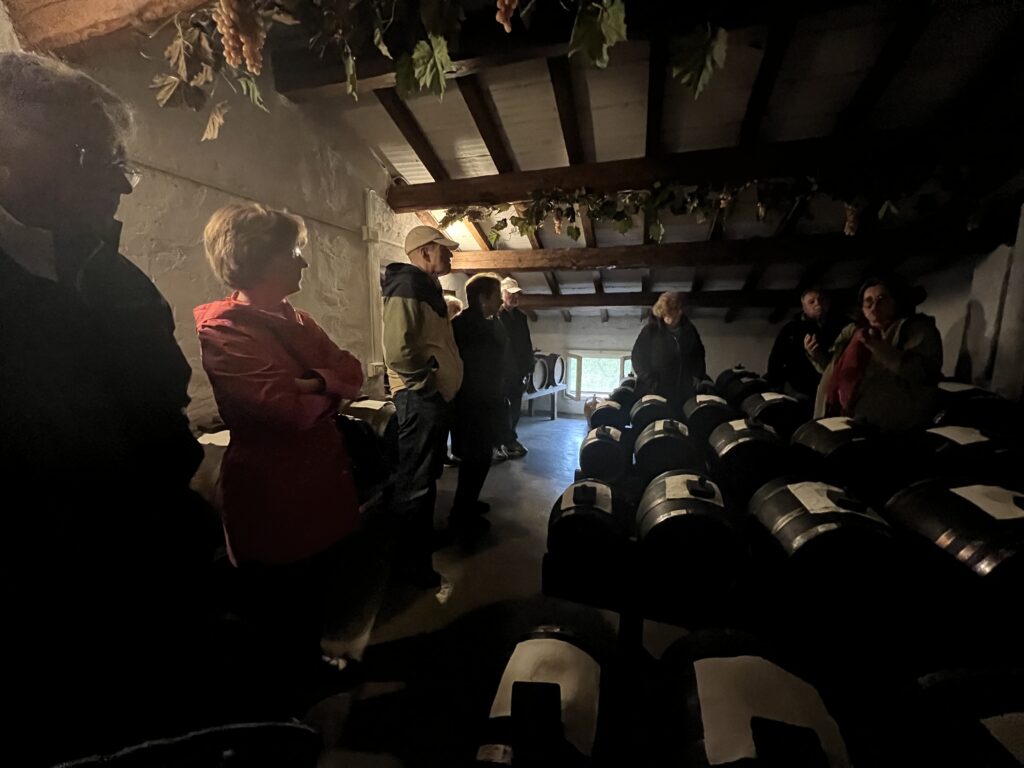
Bologna is for Food Lovers
Bologna is the largest city in the Northern region of Emilia-Romagna. Bologna is also the capital of the region. A rich city, known for its prestigious schools, medieval towers, churches, and art, Bologna is a well-respected and important city for Italy. If you walk around Bologna, a pedestrian friendly city, you will immediately notice the beautiful porticoes. Some 25 miles of the city center is sheltered from the elements of rain and sun, thanks to these beautiful and picturesque porches. They connect churches and other city buildings. The city is also renowned for some of the country’s best schools and universities and is also home to the world’s oldest university. Dante was a student in Bologna in the 13th century.
If you are walking around Bologna, you’ll certainly notice the famous towers of Bologna. While only about 20 remain from some 200 that were built between the 12th and 13th century, the towers were once used as a status symbol of wealth. Le Due Torre, or Two Towers, are the most famous ones in Bologna and stand practically next to each other. If you’re looking straight at them, don’t worry, you’re not getting dizzy. They have a slight “Pisa” effect as both lean a bit. And if looking at them reminds you of New York City’s fallen twin towers, it’s because Minoru Yamasaki, the architect for the magnificent structures is said to have been inspired by Bologna’s Due Torre.
UNESCO Designation
In 2006, the city was named a UNESCO City of Music, thanks to its rich musical practice. The Teatro Comunale di Bologna, Bologna’s opera house, is one of the most important theaters in Italy. The city is also host to numerous festivals, including the International Contemporary Music Festival, International Classical Music Festival, and the Italian Autumn Jazz Event. Other countless celebrations also take place in Bologna. As such, the city is always festive and jovial.

Bologna La Grassa
Now, let’s talk about food. Bologna is Italy’s food capital and affectionately known as “Bologna, la Grassa” or “Bologna the fat one.” While some say that the lunchmeat “boloney” was named after the city, the two have nothing in common. While Bologna is home to mortadella, a delicious pork product, served either cubed or thinly sliced, and believed to be the inspiration to boloney, the two meats have no actual resemblance. Mortadella is to Bologna what Prosciutto di Parma, is, well, to Parma. Enjoyed deliciously as is, it is also an important filling for stuffed pasta, such as tortellini, another famous dish of this city. Every October, the city celebrates this iconic staple with its own festival. Only pork, pork fat and spices are used in making mortadella, while boloney is actually a combination of several meat scraps and meat ends. Boloney is a “mortadella knock-off” at best.
Bolognese Sauce and Tagliatelle
Tagliatelle al ragu is another staple of Bolognese cuisine. Known to many in the US as “Bolognese sauce,” it is typically made with ground pork and veal, carrots, celery and tomato sauce. Like all Italian recipes, there are variations, including the addition of heavy cream, dry porcini mushrooms or wine. Often, tough not exclusively, butter will be used as the fat, as oppose to oil. The Bologna Chamber of Commerce protectively holds the “official” recipe. Served not with spaghetti, as perhaps in other parts of Italy, it is usually served with freshly made egg noodles called tagliatelle.
Speaking of freshly made pasta, it’s unlikely that you’ll find better tasting fresh pasta anywhere else in Italy. While many Southerners make fresh pasta with just flour and water, the Bolognese add eggs. Fresh pasta is not only used to make the tagliatelle, but for lasagna, tortellini and also its larger counterparts, tortelloni. You will find tortellini in brodo, at many restaurants, and while it sounds simple, the flavor of both the broth and tortellini is impeccable.

Photo Credit: Lazy Italian Culinary Adventures.
The Indisputable King of Cheeses
A blog post on Bologna and Emilia Romagna would be incomplete without the mention of specialties such as the indisputable king of cheeses, Parmigiano Reggiano cheese. Easily identified by the markings on the rind, Parmigiano Reggiano cheese is protected by the Denomination of Origin and must follow strict guidelines and inspections. It can only be produced in the cities of Bologna, Parma, Reggio Emilia, Modena and Mantua. The cows that produce the milk used in making this specialty are fed only local grass and natural feed. No additives go in the milk and after the salting process, the curing lasts anywhere from 12 – 36 months. Do not be fooled by what we in the US call “parmesan,” much like the boloney, it’s a knock-off best left on the shelf.

Photo Credit: Lazy Italian Culinary Adventures.
The Real Traditional Balsamic Vinegar
And what goes better on a nice piece of parmigiano cheese but a nice drizzle of Traditional Balsamic Vinegar? Made from the cooked grape “must” of white trebbiano grapes and aged for at least twelve years, the real “Traditional Balsamic Vinegar of Modena” is also protected by the Designation of Origin and is produced in the city of Modena, near Bologna. Classified as a condiment and not vinegar, the Traditional one is thick, syrupy and sweet. It goes just as well on a piece of parmigiano as it does on fresh cut strawberries.
What we find on grocery store shelves in the States and on restaurant tables is not “Traditional Balsamic Vinegar.” Similar in name, non-traditional balsamic vinegar of Modena is however, classified as vinegar. It does not have the requirement of it being cooked and is a combination of various musts, vinegars and in some cases, caramel. While a decent alternative for salads and every day use (be sure to buy the one without caramel), it should not be confused with the real thing. Don’t be shocked when the price will reflect its authenticity.

Photo Credit: Lazy Italian Culinary Adventures.
Tried and Tested Recommendations in Bologna
Click shop name below to be taken directly to their website.
Drogheria Gilberto
Via Drapperie, 5/A, 40124 Bologna
A family shop since 1905, Gilberto is indeed a food souvenirs mecca. While small in size, it offers authentic and regionally made products that even the locals appreciate. Here you can purchase wine, liquors, chocolates, sweets, oils and other typical products.
A. F. Tamburini
Via Caprarie, 1, 40124 Bologna
Centrally located in the city center since 1932, Tamburini is an institution in itself for the Bolognese. Here you will find freshly made tortellini, parmigiano, mortedella made in house, various salumi, breads and oils. Sweets made by locals can also be found here. It also offers a casual sit-down restaurant that’s ideal for anyone looking for delicious cuisine without the high price tag.
Bottega Portici
Piazza di Porta Ravegnana, 240126, Bologna
Bottega Portici is indeed unique experience. Part pasta shop, part café, part cafeteria, all with an open floor concept. It’s a great place for locals to buy their Sunday tortellini and for travelers to sit down with a cappuccino and freshly made cream cornetto. A casual concept that the locals love, it’s often filled with local students looking for cheap, while still delicious, food.
Paolo Atti & Figli
Via Caprarie, 7, 40124 Bologna
A family owned shop since 1868, Atti is the go-to shop for locals. This is where they go for breads, dry biscuits, cakes, seasonal panettone, and freshly made pasta. A not-to-be missed spot, be sure to take advantage of their extensive samples and decide for yourself what your favorite is.

Photo Credit: Lazy Italian Culinary Adventures.
Ristorante Vicolo Colombina
Vicolo Colombina, 5B, 40123 Bologna
Located on a little vicolo, or alley, Vicolo Colombina offers traditional dishes such as tortellini in broth, tagliatelli al ragu and a large selection of local salumi. Owned by Massimiliano Poggi, this is a favorite of the locals and visitors. On a recent visit, the group enjoyed the passatelli in rabbit ragu and the chicken cacciatore.
Osteria Bartolini
Piazza Malpighi, 16, 40123 Bologna
If you’re maxed out on tartollini and mortadella, than head to Osteria Bartolini. Claiming to bring the sea to Bologna, Bartolini offers a large selection of seafood dishes from seafood risotto, to a grand mixture of fried seafood with house made potato chips. If you’re feeling for something fried, opt for the fried seafood platter serving fish without the bones.
Leave a Reply

What to Pack for Italy
Cosa Mettere in Valigia per l'Italia
Everyone is always asking me what they should pack for Italy,
so I’ve created a quick reference guide that you can use for your next trip.
Hint: You don’t need nearly as much as you think you do!

2 Comments
Francesca
This is such great information
Thank you so much for sharing and I do hope to visit Bologna some day
Ciao Bella
Annette
Sounds like I would put some pounds on in Bologna. Someday……..